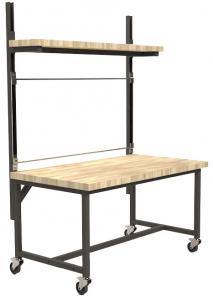10 Ways to Future Proof Supply Chain and Manufacturing Operations

Formaspace created this new protective shield accessory that mounts to new or existing Formaspace workbenches. If you already have Formaspace workbenches, this is an easy upgrade that can be performed in the field with simple hand tools.
The pandemic has created profound changes in manufacturing and supply chain operations. Here are ten actions you can take now to prepare for what’s coming next.
— A favorite quote of baseball legend Yogi Berra
Let’s take a moment to reflect on how much conditions have changed since Q4 of 2019.
Back then, your company was probably putting the final touches on its financial and operational plans for 2020.
As you polished the shiny deck of PowerPoint KPI slides to present at management review meetings, the advice of supply chain logistics and manufacturing operations consultants might have been ringing in your ears: “Are we undertaking the right kind of customer-centric, value-added digital transformation across our supply chain that’s in line with industry best practices? Are we leveraging the power of the cloud to ensure end-to-end supply chain transparency, minimize our Capex and inventory carrying costs, and elevate our stock price and EBITA?”
At this moment, if someone told you, that in just a few weeks, major sectors of the US (and world) economy would be shut down over a pandemic, that e-commerce sales would jump up by an extra $52 billion dollars, that 96% of passenger airline flights would be cancelled (and many of the remaining flights would have cargo packages strapped into the seats) – and most shockingly — that supply chain logistics and manufacturing operations would be headline news nearly every day, you would have dismissed it as crazy talk.
But then it happened. And here we are.
“The Best Laid Plans Of Mice And Men Often Go Awry.”
— Robert Burns in his poem To a Mouse
So where do we go from here?
What can you do now to ensure that your business thrives during these difficult times?
Here are ten steps to consider:
1. Ensure The Safety And Health Of Your Workers
Taking care of your employees should be at the top of your to-do list.
Implementing the new recommendations from OSHA and the CDC to protect workers on the job is a crucial first step. Across the country, facility managers are busily stepping up cleaning and hygiene procedures, as well as reconfiguring floor plans to increase social distancing at work and are installing new furniture accessories (such as transparent barriers) to discourage virus transmission on the job.
Tip: see our in-depth articles on how schools and offices, laboratories, and warehousing/distribution centers and manufacturing facilities can prepare their workplace environments for returning employees.
Managers also need to keep in mind that many of their employees have had completely different experiences as a result of the pandemic lockdown.
On one hand, you may have essential employees who have continued to work tirelessly during the epidemic (such as Formaspace employees working two shifts to produce workstations for GM’s new ventilator plant, or Novartis employees working staggered shifts to produce high demand pharmaceuticals).
On the other hand, employees returning to work for the first time after the pandemic lockdown will need reassurance and guidance as they come to terms with many of the changes brought about by the virus pandemic – from new procedures to stay socially distant on the elevator, to reduced access to on-site cafés and kitchens, to newly instituted schedule changes (such as office employees working in shifts), and proper procedures for wearing masks and other PPE.
Don’t overlook the need to support employees who may be having emotional difficulties, even mental health problems, brought on by all these sudden changes. Mollie West Duffy and Liz Fosslien, co-authors of the book No Hard Feelings: The Secret Power of Embracing Emotions at Work, recently spoke to Paul Michelman, host of MIT Sloan Management Review’s Three Big Points podcast on business management, where they point out that smart managers need to embrace empathy in times of crisis. “If we don’t address or acknowledge our feelings at work, they come out in unproductive ways,” says Duffy. It’s not that they go away. And so the best thing is to acknowledge them and learn how to actually use them in a healthy way.”
Given the sensitivity surrounding the virus pandemic, managers may also tend to shy away from broaching the performance of their employees, especially those currently working from home. Liz Kislik, a management consultant and executive coach, disagrees; she stresses the importance of making personal phone calls (not a zoom meeting) to find out what is happening with an underperforming employee, and how you can work together to help things moving forward.
2. Get Closer To Your Customers, Much Closer
If you’ve had a rock-steady customer for 20 years, do you really know them?
Maybe you once did — but it’s hard to know what they’re thinking now.
Not sure if you agree? Think about your own circumstances and the ways your business has changed since January 1, 2020 — now extrapolate this to your business partners.
At this very minute, your customers, and, very importantly, their customers, could be changing up their business plans in ways that will dramatically affect their purchasing plans and their choice of vendors – any of which result in a direct effect on your bottom line.
What should you do?
Many of the traditional ways of conducting business are currently on ice, such as trade shows, roadshows, press tours, sales meetings, and the like.
But the telephone is available.
Even if you have a direct or indirect sales channel that should be providing you up-to-date sales forecast information, make it your business to call your customers and find out what your customers are thinking. Are there purchasing plans changing? Do they have some new requirements that you could satisfy? What can you do today to help them survive; even thrive during these difficult times?
Dig a little deeper to gather further business intelligence on your customer’s customers. When speaking to them, can you identify if there will be sudden shifts in demand (good or bad)? Can you discern any new opportunities? How can you be of service?
Now is also a good time to leverage the power of a Customer Advisory Council, if you have one in place. (If not, now’s a good time to create one.) These types of councils, which exist under the guise of many names (user groups or associations, online forums, special interest groups, etc.) can be invaluable in providing honest, useful, actionable recommendations to improve your products and services.
Unfortunately, due to the coronavirus pandemic, most of the traditional in-person meetings that were scheduled to take place in conjunction with trade shows, annual sales meetings, product launches, won’t be happening this year. If that’s the case, now’s the time to re-create them in online form so that you don’t miss out on crucial market intelligence direct from your customers, including the new potential sales opportunities or new product or service offerings that you hadn’t thought of before.
3. Be Flexible When Offering Standardized And Customized Options
Flexibility is the watchword during this coronavirus pandemic.
On the one hand, you might find it possible to modify your existing product line to make it fit the current needs of your existing customers.
Such was the case here at Formaspace. Based on customer suggestions, we were able to quickly create new accessories (such as transparent shields) to transform our existing line of workstations into upgraded products that meet new CDC recommendations for protecting workers on the job. And, thanks to our flexible production lines, here at our Austin Texas factory headquarters, we have also been able to supply our existing customers with modular upgrade kits so that they can have the latest safety features as well.
Read more...
Julia Solodovnikova
Formaspace
+1 800-251-1505
email us here
Visit us on social media:
Facebook
Twitter
LinkedIn
Legal Disclaimer:
EIN Presswire provides this news content "as is" without warranty of any kind. We do not accept any responsibility or liability for the accuracy, content, images, videos, licenses, completeness, legality, or reliability of the information contained in this article. If you have any complaints or copyright issues related to this article, kindly contact the author above.


